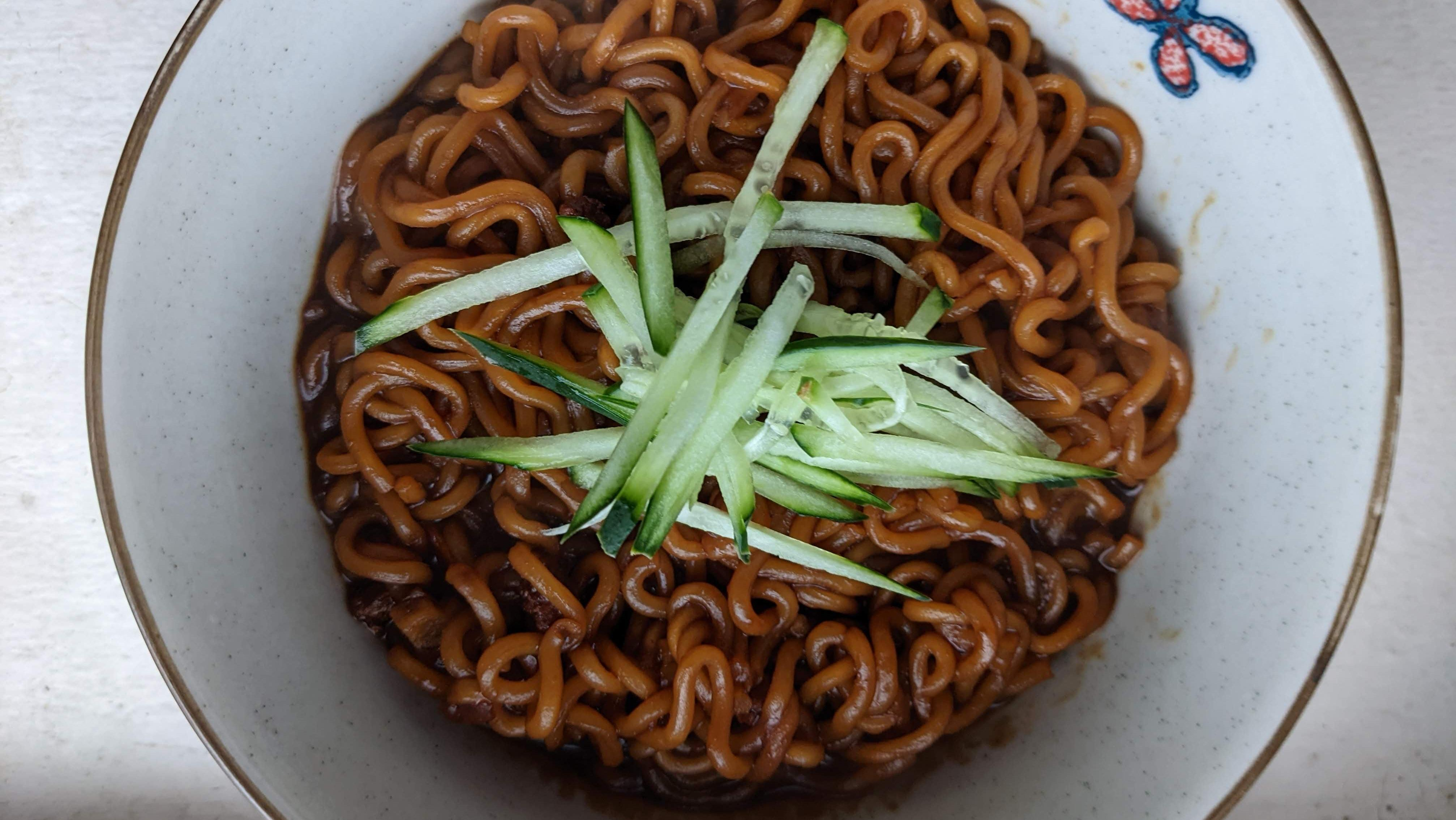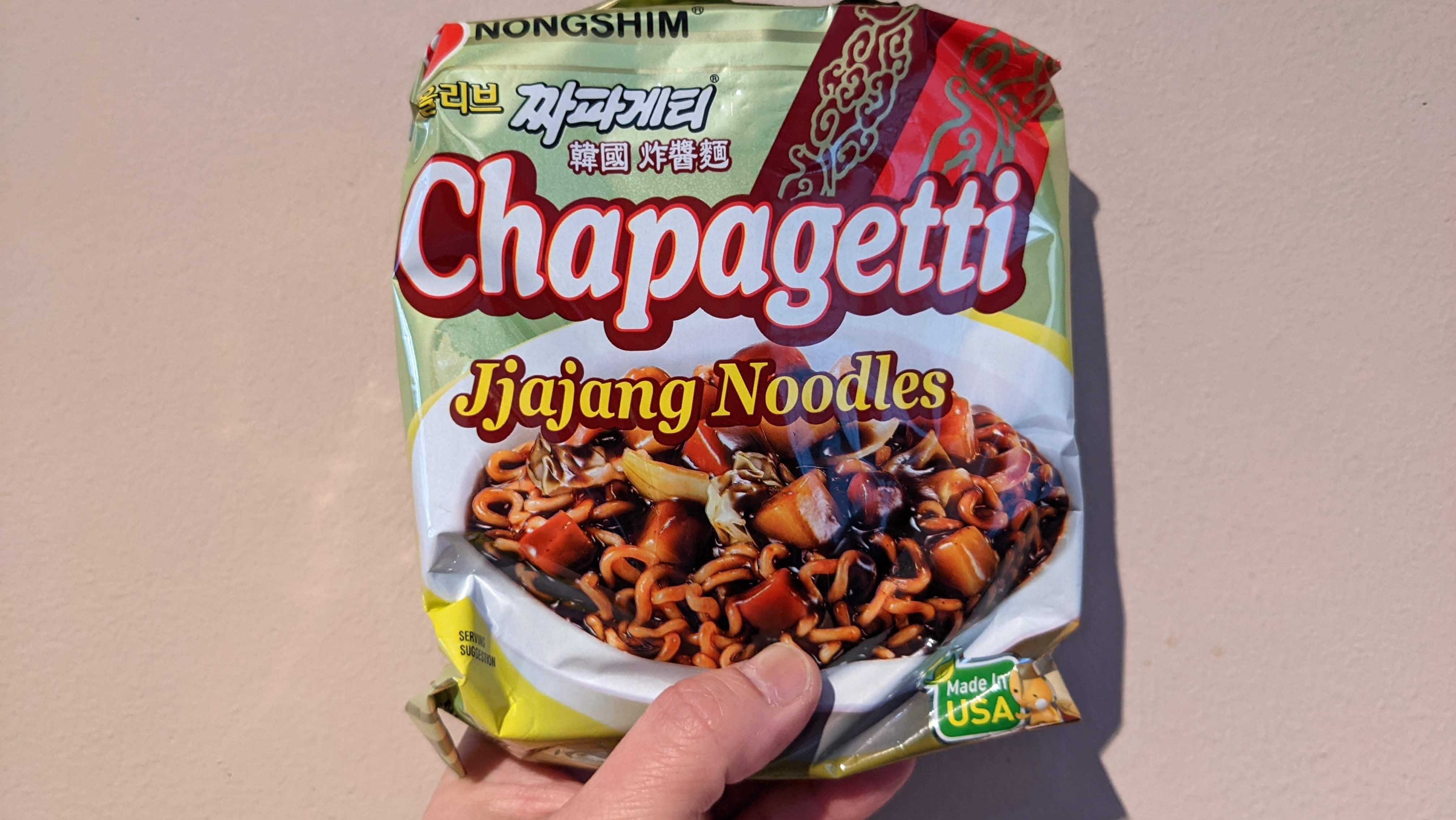Chapagetti Is The Instant Noodle You Never Knew You Craved
This classic instant noodle dish doesn't come with a spicy broth, or any broth at all.
Instant ramen (or ramyeon, as we Koreans call it) is a staple in many Korean households. We've all got our favorite brands: my father likes Shin, I like Neoguri. But even I crave a little bit of variety in my instant noodle diet, and sometimes I'm not in the mood for my beloved spicy Neoguri. On those occasions, I turn to an instant noodle dish that has no soup at all, and that's Chapagetti.
What is Chapagetti?
Chapagetti is a variety of instant ramen/ramyeon that features the same dehydrated fried noodles as a packet of your typical soupy stuff. It's manufactured by Nongshim, a juggernaut in the Korean packaged food world. But Chapagetti is different from a typical bowl of instant ramen, and there's something remarkably special about it. It all comes down to the sauce.
The sauce comes in powder form within the package, but becomes a glossy black bean dressing for the instant noodles once it's fully prepared, by adding water and boiling all of the ingredients together. As the noodles cook and absorb water, the sauce reduces and becomes silky. It's not spicy (like, no pepper at all), but it's salty, savory, and comforting, in a rich and soul-warming sort of way.
It comes from Korea’s most popular takeout food
Chapagetti is based off a Korean-Chinese noodle dish called jjajangmyeon, which is Korea's most popular takeout food. A heap of wheat-based noodles are served with a huge ladleful of black bean sauce on top, usually containing a blend of onions, carrots, potatoes, zucchini, and sometimes tiny bits of pork. You stir the sauce into the noodles yourself and then go to town.
If you've ever seen a K-drama, you may have even noticed characters casually talking about going to get jjajangmyeon from time to time. It also made a prominent appearance in the Academy Award–winning movie Parasite, when a character requests "jjapaguri," a mixture of Chapagetti and Neoguri. The English subtitles changed jjapaguri to ram-don, implying a mixture of ramen and udon. Whatever you call it, though, it's easy to make at home.
Jjajangmyeon is one of the most famous Korean-Chinese dishes around, as a hybrid of Chinese and Korean cooking. If you ever go visit a Chinese restaurant that serves this dish, you'll also want to search the menu for one called jjampong, a blazing-hot seafood noodle soup that is just as delicious. These two Korean-Chinese dishes are so popular that some restaurants serve both in a bowl with a divider in it so that you don't have to choose between them. That's like having half a cheeseburger and half a fried chicken sandwich in the same sitting.
Is Chapagetti an accurate depiction of a fresh bowl of jjajangmyeon? Absolutely not. It's like what instant ramen is to a homemade bowl, or what a frozen pizza is to a pie that's gone through a wood-fired oven. It's sort of an echo of jjajangmyeon, but that doesn't mean it's any less delicious.
About the name: "Chapagetti" cracks me up. If the "-pagetti" part looks suspiciously familiar to you, it's because the name is indeed a portmanteau! The "cha" is sort of how you pronounce the "jja" at the beginning of jjajangmyeon, and the "pagetti" is indeed taken from the word spaghetti.
Many of you might already be familiar with Chapagetti, even if you haven't tried it. That's because it's frequently displayed next to the big popular instant ramen brands in chain grocery stores, so I'm guessing you've walked by it even if you haven't picked any up for yourself.
One of the things I always found interesting about Chapagetti is that it comes with a little packet of plain vegetable oil, alongside the dehydrated vegetable packet and the black bean powder. The oil is about a teaspoon's worth, just enough to give each slurp a velvety finish. There's something weirdly special about drizzling it into the saucepan, like you're adding a special garnish.

Speaking of garnishes, one of the best parts about making Chapagetti is that you don't need to add anything to it. I almost won't eat a bowl of instant ramen if I don't have at least an egg to toss in (cheese toast optional), since it feels naked without an accompaniment. Chapagetti, meanwhile, works just great on its own. If you'd like to add a little freshness, you can julienne some cucumber into matchsticks and toss those on top; otherwise, it's totally satisfying by itself.
Next time you're at the store picking up some of your favorite instant ramen, pick up a few packs of Chapagetti. I have a feeling you'll grow to love it as much as I do.

